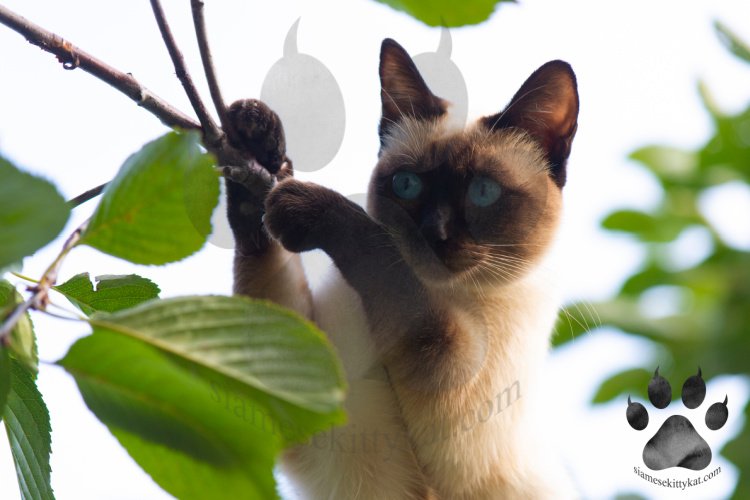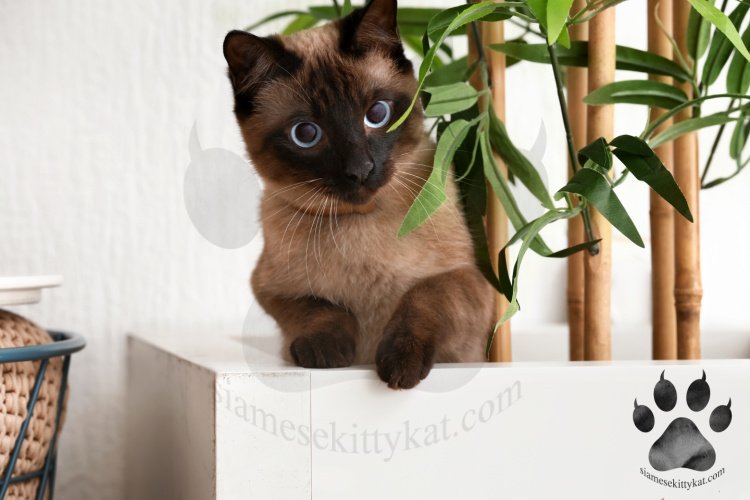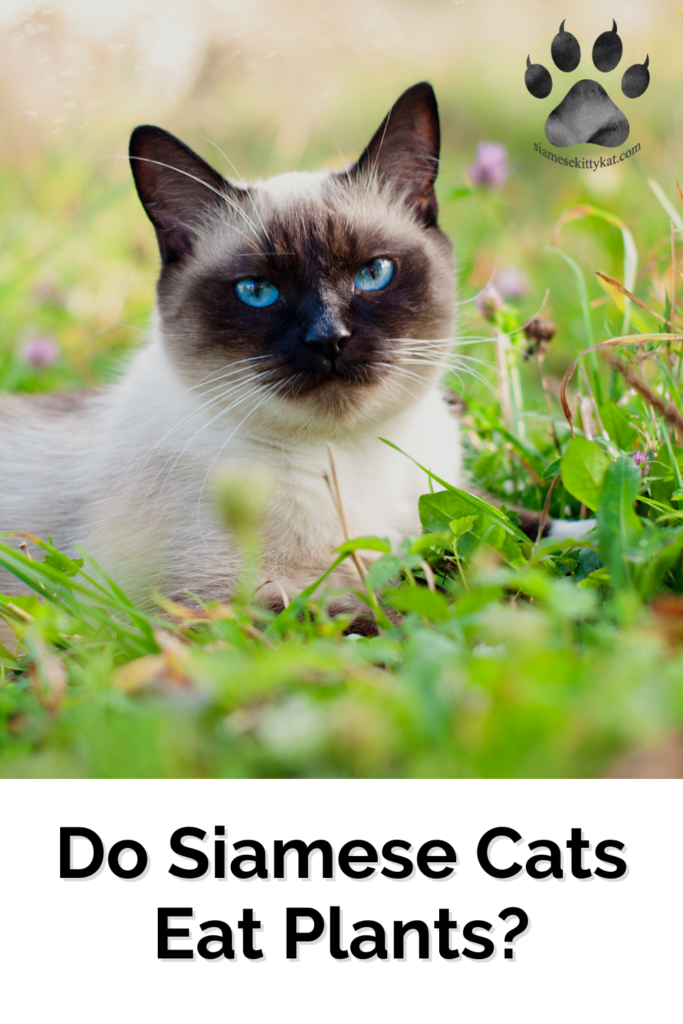Yes, Siamese cats do eat plants!
If you’ve ever seen your Siamese chewing on your new plant baby and thought, “Why do you strive to destroy the things I love?” chances are you’ll want to know how to put a stop to this strange attraction.
I know from personal experience how hard it can be to cat-proof plants; Batman went through a phase of attacking any plant I brought into the house, preferring to have a nibble on that opposed to his actual cat food.
If you know anything about cats and plants, you’ll know quite a few of them can be poisonous when ingested. So, it is essential to know which ones are safe to have around.
Through many trials and tribulations, I came up with a few ways to ensure my house plants live a long and happy life without the interference of a paw or two.
Why is my cat eating plants?
To be completely honest with you, no one really knows the reason why cats eat plants. Since they’re primarily carnivores, it seems odd that they would enjoy eating our beloved house plants.
However, there are a few theories as to why cats do this:
It turns out the reason why Batman grew a liking to my house plants was due to stress. We had an out-of-town friend stay over for a few weeks, so our usual schedule was a little disrupted.
Safe to say Batman didn’t like this. We’re still not sure if it was a strange coping mechanism or a way to say, “Hey, I don’t like this change!” but once things got back to normal, he quit his habit.
Which plants are toxic to cats?
Several house and garden plants are toxic to your cat, so you must know which ones are safe and which are not.
All of the plants above are toxic to cats; however, Lilies are perhaps the most dangerous. If your Siamese comes into contact with pollen from a lily and ingests it, there’s a chance that they could experience kidney failure.
Unless you have a surefire way to keep your Siamese away from these plants, it is best to keep them out of your house altogether.
Do cats know not to eat poisonous plants?

Thankfully, cats are clever little creatures, the Siamese especially. They are relatively careful about what they eat, making poisoning quite rare in cats. Although, it does happen – sometimes by accident, sometimes on purpose.
For example, a friend of mine had some tulips in her house. She knew that they weren’t suitable for cats, so she kept them in her bedroom, where the cats weren’t allowed in.
Unfortunately, some of the pollen from the tulips attached to her sweater. When she took said sweater off and placed it on the couch, her cat came along and sat on it.
When he jumped off, he decided to have a little groom, in turn ingesting the pollen that was trapped in his fur.
Fortunately, his reaction wasn’t anything serious, just slight swelling around the mouth and eyes. But it did put my friend off buying tulips ever again!
What are the symptoms of plant poisoning in cats?
The symptoms your cat will experience all depend on which plant was ingested. Some signs can appear quickly, while others may take some time to develop.
Do indoor cats need cat grass?
No, indoor cats don’t need cat grass, they just enjoy it.
You won’t need to rush down to your local pet store to pick up some grass, because it’s not actually a necessary part of their diet.
If you’re feeding your kitty a well-balanced diet, having some cat grass around the house can just be a plus. For indoor cats, cat grass provides a source of environmental enrichment, and can even provide them with vitamins A and D.
Keep in mind that cat grass is usually made up of a combination of grasses such as barley, oat, wheat and rye, so if you’re looking to get your cat some grass, it is better to pick up a kit where you can grow your own.
What should I do if my cat has eaten a plant?
If you’ve noticed your cat chewing on a plant and you’re not sure whether it’s safe or not, you should get in touch with your vet ASAP.
Similarly, if you’ve noticed any of the above symptoms and your cat is an outdoor cat, or you have plants in your home, contact your vet.
Before you head to the clinic, do the following:
How do I stop my cat from eating my plants?

Even if the plants in your house are safe for your cat to eat, chances are you won’t want them nibbling on them! Here are a few tried and tested ways to get your Siamese to stop eating your plants:
1. Keep Them Out Of Reach
The placement of your beloved house plants makes all the difference. If you’ve popped them on top of a shelf, chances are they’re just going to jump and climb for a taste of that green goodness.
I found the best way to keep plants out of paw’s reach is to place them in a hanging basket. This way, no leverage allows them to jump or climb. They’ll probably sit underneath the hanging plants with a look of longing in their eyes, but that’s about it.
2. Give Your Siamese Their Own Plants
Want your Siamese to lay off your indoor garden? Give them one of their own! There are plenty of plants out there that are safe and even good for them to have a little nibble on.
A crowd favorite in my house is, of course, the catnip. They also enjoy pet grass we picked up at the local pet store. Place these pants in their favorite places, and they’ll soon forget all about your house plants.
3. Take The Tastiness Away
Do you think your Siamese would still want to chew on your plants if they tasted like vinegar? Probably not.
I found the best way to keep my Siamese kitties away from my plants was to make them as unappealing as possible. I simply mixed lemon and water together with a bit of lime juice, sprayed the concoction on my plants, and bam, no nibblers. Cats typically have an aversion to citrus.
If that doesn’t work, you can always try vinegar. Of course, dousing your plant with vinegar isn’t going to be very good for it, so instead, try soaking cotton balls in vinegar and placing them on top of the soil.
Another thing to note is that sometimes the planter attracts your Siamese and not the plant itself. They may mistake it for another litter box, so try putting some decorative pebbles on top of the soil to avoid any accidents.
4. Keep Them Stimulated
As I mentioned, cats can go for your plants when they’re bored. This is typically down to the movement of the plant; one swipe can have it bobbing around like their new plaything. If they have any pent-up energy, they’ll end up attacking your plants as a result.
Schedule a few daily play sessions with your cat, especially if they are a Siamese. You can use a feather wand, a ball, a mouse – anything that tickles their fancy. About 10 – 15 minutes of vigorous play will leave no energy to mess with a still house plant.
Is it ok for cats to eat leaves?
If the leaves aren’t from toxic plants, it is okay, and sometimes beneficial, for your Siamese to eat leaves. However, it boils down to the question, “are you okay with your cat eating your plants?”
Most of the time, that answer is a solid ‘no’, unless they are plans specifically put there for your cat to enjoy.
If you want your cat to stay out of your plant pots, try making the plants as unappealing as can be, spraying them with citrus, placing vinegar cotton balls around the plant, etc.
If all else fails, get them are personal garden to enjoy!
Want to immerse yourself more in the captivating world of Siamese cats? I’ve got all the information you need from their distinct color points to their fun personalities: Siamese Cats: Unique Features and Personality
Get your FREE Siamese Cat 2026 Printable Calendar

